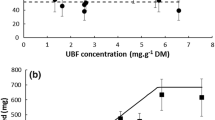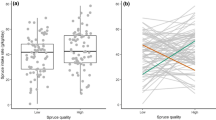Abstract
Generalist mammalian herbivores exploit a diverse diet. A generalised feeding strategy utilises a mixed diet to obtain a range of nutrients and to reduce the detoxication load of similar groups of plant secondary metabolites (PSMs). There is limited research investigating how mammalian herbivores achieve this dietary mixing in their daily foraging activities. We investigated the patterns of, and behaviours associated with, dietary mixing in a generalist mammalian folivore, the common brushtail possum (Trichosurus vulpecula). Possums were offered foliage of two eucalypt species (Eucalyptus globulus and E. regnans) as either (a) Full choice: both species offered for 8 h; (b) Restricted choice: both species offered for 2×2 h blocks; (c) G–R no choice: E. globulus offered for the first 4 h, E. regnans offered for next 4 h; and (d) R–G no choice: E. regnans offered for first 4 h, E. globulus offered for next 4 h. We hypothesised that possums would maximise intake on the Full choice diet, where time availability was greatest in combination with a choice of foliage. We also hypothesised that diet switching, defined as the frequency of changing between food types while feeding, would play a fundamental role in maximising intake. Possums achieved maximum intake on the Full choice diet and minimum intake on the No choice diets. Although intake was similar between the Restricted choice and No choice diets, possums achieved this intake in half the amount of time when able to switch regularly between foliage on the Restricted choice diet. We conclude that a generalist herbivore’s ability to effectively switch diets when foraging is fundamental to maximising intake. Hence, the degree of plant heterogeneity in an environment, and the spatial scale at which it occurs, may affect an herbivore’s foraging decisions and, ultimately, influence its foraging efficiency.






Similar content being viewed by others
References
Boyle RR, McLean S, Foley WJ, Davies NW (1999) Comparative metabolism of dietary terpene, p-cymene, in generalist and specialist folivorous marsupials. J Chem Ecol 25:2109–2126
Close DC, Davies NW, Beadle CL (2001) Temporal variation of tannins (galloylglucoses), flavonols and anthocyanins in leaves of Eucalyptus nitens seedlings: implications for light attenuation and antioxidant activities. Aust J Plant Physiol 28:269–278
Cork SJ, Pahl L (1984) The possible influence of nutritional factors on diet and habitat selection by the ringtail possum (Pseudocheirus peregrinus). In: Smith AP, Hume ID (eds) Possums and gliders. Australian Mammal Society, Sydney pp 269–276
Dearing DM, Cork S (1999) Role of detoxification of plant secondary compounds on diet breadth in a mammalian herbivore, Trichosurus vulpecula. J Chem Ecol 25:1205–1219
Fitzgerald AE (1984) Diet of the possum (Trichosurus vulpecula) in three Tasmanian forest types and its relevance to the diet of possums in New Zealand forests. In: Smith AP, Hume ID (eds) Possums and gliders. Australian Mammal Society, Sydney pp 137–143
Freeland WJ (1991) Plant secondary metabolites: biochemical coevolution with herbivores. In: Palo RT, Robbins CT (eds) Plant defenses against mammalian herbivory. CRC, Boca Raton pp 61–81
Freeland WJ, Janzen DH (1974) Strategies in herbivory by mammals: the role of plant secondary compounds. Am Nat 108:269–289
Freeland WJ, Winter JW (1975) Evolutionary consequences of eating: Trichosurus vulpecula (Marsupialia) and the genus Eucalyptus. J Chem Ecol 1:439–455
Jones TH, Potts BM, Vaillancourt RE, Davies NW (2002) Genetic resistance of Eucalyptus globulus to autumn gum moth defoliation and the role of cuticular waxes. Can J Forest Res 32:1961–1969
Lawler IR, Foley WJ, Eschler BM (2000) Foliar concentration of a single toxin creates habitat patchiness for a marsupial folivore. Ecology 81:1327–1338
le Mar K, McArthur C (2005) Habitat selection by common brushtail possums in a patchy eucalypt-forestry environment. Aust Mammal (in press)
Lowther JR (1980) Use of a single sulphuric acid-hydrogen peroxide digest for the analysis of Pinus radiata needles. Commun Soil Sci Plan 11:175–188
McArthur C, Goodwin A, Turner S (2000) Preferences, selection and damage to seedlings under changing availability by two marsupial herbivores. Forest Ecol Manag 139:157–173
O’Reilly-Wapstra JM, McArthur C, Potts BM (2004) Linking plant genotype, plant defensive chemistry and mammal browsing in a Eucalyptus species. Funct Ecol 18:677–684
O’Reilly-Wapstra JM, Potts BM, McArthur C, Davies NW, Tilyard P (2005) Inheritance of resistance to mammalian herbivores and of plant defensive chemistry in an Eucalyptus species. J Chem Ecol 31:357–375
Pass GJ, Foley WJ (2000) Plant secondary metabolites as mammalian feeding deterrents: separating the effects of the taste of salicin from its post-ingestive consequences in the common brushtail possum (Trichosurus vulpecula). J Comp Physiol B 170:185–192
Pfister JA, Provenza FD, Manners GD, Gardner DR, Ralphs MH (1997) Tall larkspur ingestion: can cattle regulate intake below toxic levels? J Chem Ecol 23:759–777
Ratkowsky DA, Evans MA, Alldredge JR (1993) Cross-over experiments: design, analysis, and application. Marcel Dekker, New York
Shipley LA, Spalinger DE (1995) Influence of size and density of browse patches on intake rates and foraging decisions of young moose and white-tailed deer. Oecologia 104:112–121
Singer MS, Bernays EA, Carrière Y (2002) The interplay between nutrient balancing and toxin dilution in foraging by a generalist insect herbivore. Anim Behav 64:629–643
Sorensen JS, McLister JD, Dearing DM (2005) Plant secondary metabolites compromise the energy budgets of specialist and generalist mammalian herbivores. Ecology 86:125–139
Westoby M (1978) What are the biological bases of varied diets? Am Nat 112:627–631
Wiggins NL, McArthur C, McLean S, Boyle R (2003) Effects of two plant secondary metabolites, cineole and gallic acid, on nightly feeding patterns of the common brushtail possum. J Chem Ecol 29:1447–1464
Acknowledgements
We thank Hugh Fitzgerald and Kit Williams for their help with setting up camera equipment. We also thank Jan Wiggins for experimental assistance and Ann Wilkinson for running colorimetric assays of the nitrogen digests. This research was approved by the University of Tasmania’s Animal Ethics Committee (Permit Number A6700) and Parks and Wildlife Service (Permit Number FA 03103). Research was funded by an Australian Postgraduate Award and the CRC for Sustainable Production Forestry.
Author information
Authors and Affiliations
Corresponding author
Additional information
Communicated by Roland Brandl
Rights and permissions
About this article
Cite this article
Wiggins, N.L., McArthur, C. & Davies, N.W. Diet switching in a generalist mammalian folivore: fundamental to maximising intake. Oecologia 147, 650–657 (2006). https://doi.org/10.1007/s00442-005-0305-z
Received:
Accepted:
Published:
Issue Date:
DOI: https://doi.org/10.1007/s00442-005-0305-z




